- Article
comprehensively covers, with pictures, various aspects of jewellery in Indian
Temple Iconography.
Indians,
right from the time they started depicting their gods on seals and murtis,
showed a great deal of love for depicting jewellery on their deities. Almost
all parts of the body from head to ears, nose, neck, chest, lower and upper
arms, fingers, waist, hip, ankle, and feet are shown with different appropriate
ornaments. Grunwedel in his writing “Buddhist Art” noted this, and stated that
“the heroic form of Indian sculptured figures has been and at all times
remained the same- they are decked as for the gala occasions” (p. 31).
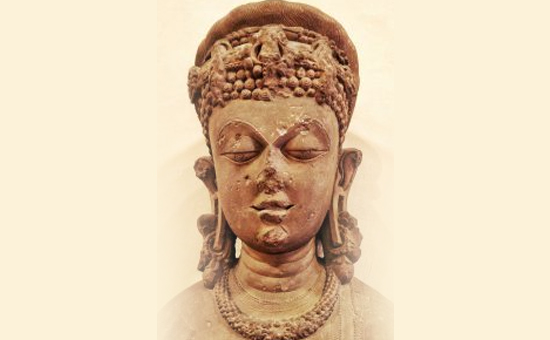 A salabhanjika with long distended ear lobes.
A salabhanjika with long distended ear lobes.
Caption
- A salabhanjika with long distended ear lobes caused owing to constant wearing
of heavy earrings, and this was once considered to be sign of great beauty.
While
Hindu deities were seen in full glory adorned with all kinds of jewellery, the
Buddhists and Jains could not show their spiritual head with ornaments, which
they made up with a greater zeal on the subordinate deities, such
as Bodhisattavas and Sasanadevatas. Only one Bodhisattava (Simhanada Lokesvara - a form
of Avolokitesvara) is nirbhusana,
that is, without jewellery, but this is because of his ideological association
with Shiva, who among the Hindu deities wears the minimum ornaments.
In
the medieval era even Buddha got endowed with a jewelled crown and a torque,
especially in the murtis from Eastern India. Even the murtis of Shiva and
Vishnu in yoga-dhyana postures are depicted with ornaments, perhaps lesser than
the other types, but definitely present. Among the rare exceptions are the two
figures of Nara and Narayana on the side niches of the Deogarh temple, where
they are depicted as two rishis and are devoid of any ornaments. This practice
of depicting even dhyana murtis with ornaments goes long back into the Harappan
culture, where a deity in yogic dhyana posture on a seal (termed as the
proto-Shiva Pashupati) is seen wearing armlets, bracelets, a torque, and a
horned crown.
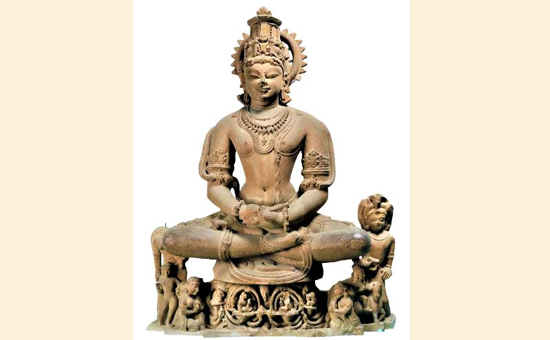 Yoga Narayana in
dhyana posture.
Yoga Narayana in
dhyana posture.
Caption
- Yoga Narayana in dhyana posture, adorned with jewellery, 10th c. CE,
Khajuraho, Chandella period. National Museum, Delhi.
Headgear and Hairstyles
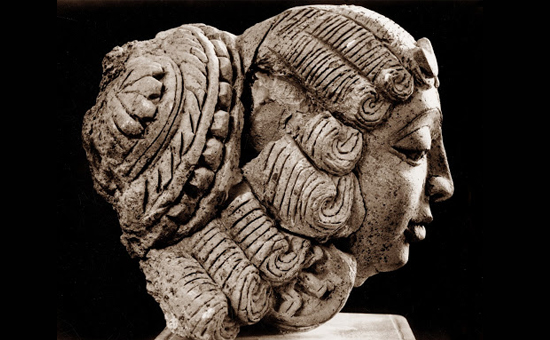 Elaborate
coiffure on a Gupta era head of Devi Parvati, National Museum- Delhi.
Elaborate
coiffure on a Gupta era head of Devi Parvati, National Museum- Delhi.
It
is beyond any doubt that the ornaments shown on the deities were also the ones
worn by the people of those times, thus providing us with a picture of the
socio-cultural lifestyle of the ancient and medieval Indians. As per
the Manasara the different types of headgears are placed under a
category known as mauli, which
are further sub divided into jatamukuta (hairstyle), kirita mukuta (crown), karanda
mukuta (crown), sirastraka
(crown), kuntala (hairstyle), keshabandha (hairstyle), dhammila (hairstyle), and alaka-cudaka (hairstyle).
Jatamukuta is seen on the
heads of Brahma and Shiva, and consists of matted hair done up in the form of
long crown at the centre of the head. Sometimes the jatamukuta may be adorned
with jewels; or in case of Shiva, with a moon and a skull. One of the names of
Shiva is Kaparddi, which means
“someone whose matted locks wave spirally upwards like the top of a shell.”
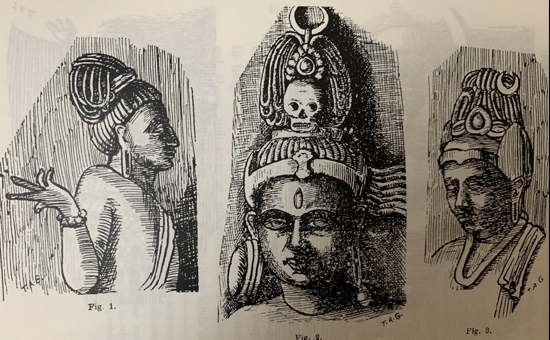 Jatamukuta. (Image from TAG Rao, Elements of Hindu iconography).
Jatamukuta. (Image from TAG Rao, Elements of Hindu iconography).
Kiritamukuta,
according to Rao is “is a conical cap sometimes ending in an ornamental top
carrying a central pointed knob, and covered with jewelled discs and bands,”
and is mostly seen on Vishnu, though it can also be worn by Surya and Kubera.
Varahamihira
while describing Vishnu as wearing earrings and a crown/kirita (kundalakiritadhari), says that Surya
should wear a mukuta, and Kubera
should be wearing a crown or a kirita that should slant on the left side of his
head (vama-kirita) (in Brhatsamhita the words kirita,
mukuta, and mauli all have the same meaning, as per Utpala).
Karanda
mukuta is a crown, which is shaped like a karanda or a bowl or a basket with
the narrow end pointing up, and is shorter in size than the kiritamukuta. This
is seen in most of the other deities, and is believed to be denoting a
subordinate position.
Sirastraka is the
elaborate turban that is worn by the Yaksas, Vidyadharas, Nagas (primarily of
the Sunga era), and by generals or parshnikas of the kings. In P.K. Acharya’s
edition of the Manasara it is said that kirita mukuta is to be worn
by a Sarvabhauma, a ruler whose
kingdom extends to the shores of the four oceans; and by an Adhiraja, a king whose control extends over
seven provinces. Karandamukuta is to be worn by a Narendra or a Chakrvartin, i.e. kings who reign over
three provinces (a lesser position than the Sarvabhauma).
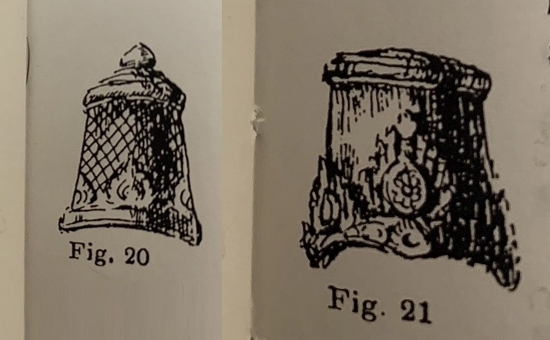 Kirita mukuta. (Image from TAG Rao, Elements of Hindu iconography).
Kirita mukuta. (Image from TAG Rao, Elements of Hindu iconography).
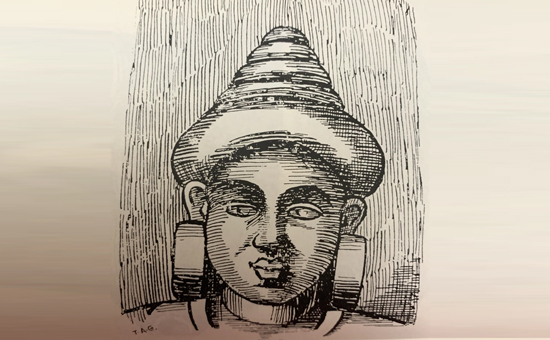 Karanda mukuta. (Image from TAG Rao, Elements of Hindu iconography).
Karanda mukuta. (Image from TAG Rao, Elements of Hindu iconography).
Kuntala, keshabandha, dhammila, and alaka-cudaka are
various ways of doing up the hair, and seen on the various devis.
According
to Manasara, the first one (kuntala)
is seen on devi Sri or Lakshmi (Indira), first and second one on devi Saraswati
and devi Savitri (kuntala and kesabandha). The 3rd and 4th styles (dhammila and alaka-cudaka) find no mention in
association with any devis, Instead, Dhammila has
been mentioned as the style to be seen on wives of smaller rulers, such as
Mandalikas; while Alaka-cudaka hairstyle
is to be worn by women who work as torch bearers of the king, and by the wives
of the sword and shield bearers of the king. These hair knots were often tied
together by flowers known as pushpapatta,
or strings of leaves known as patra-patta,
or jewelled bands known as ratna-patta.
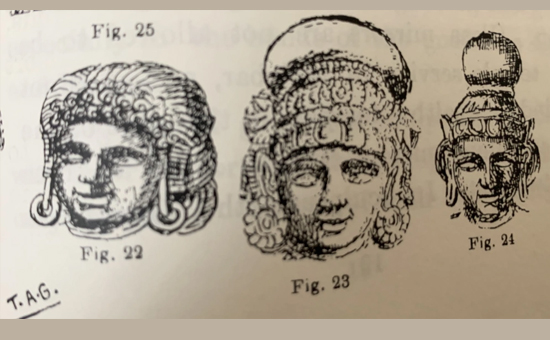 Hairstyles of
women (Image from TAG Rao, Elements of Hindu iconography).
Hairstyles of
women (Image from TAG Rao, Elements of Hindu iconography).
In
eastern India, a typical hairstyle has been used to denote Krishna and other
young deities, which has been termed as kakapaksa, a type of hair arrangement on two sides of the head
where the hair is arranged in three tufts with the side tufts fanning out like
the wings of a crow and hanging down to the temples.
In
Gandhara art different hairstyles are seen on the heads of Avalokitesvara and Maitreya,
where in the former the hair is elegantly arranged upwards with jewelled bands
encircling it, while the latter is with long hair tied sideways in double knot
on the centre of the cranium. In few late Gandhara, Gupta, and post Gupta era
Buddha figures it is seen that his hair is arranged in short separate curls,
and the direction of the curls is from left to right (daksina-vartakesa, which is the sign of a mahapurusa, a mahapurusalaksana).
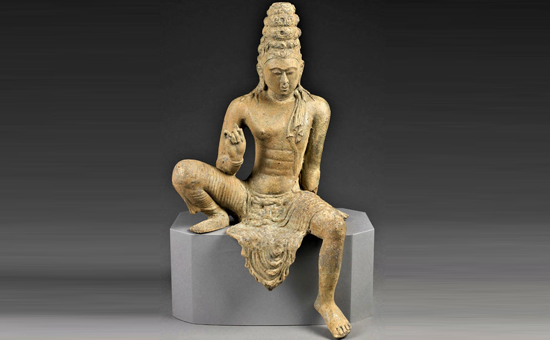 Avalokitesvara.
Avalokitesvara.
Caption
- Avalokitesvara the hair is elegantly arranged upwards with jewelled bands
encircling it, from Sri Lanka, ca. 750 CE
Earrings
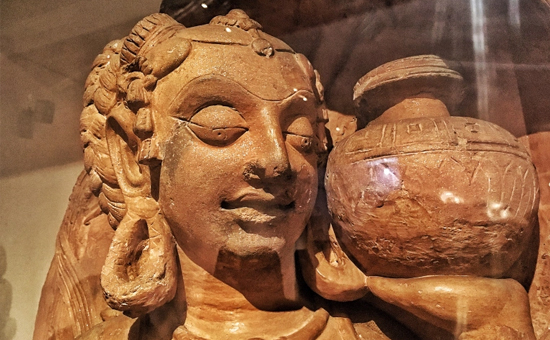 Devi Ganga with large hanging earrings.
Devi Ganga with large hanging earrings.
Caption
- Devi Ganga with large hanging earrings, hair tied in a tight plait, and other
beautiful head accessories, Gupta period, National museum- Delhi.
Piercing
the ear lobes for wearing earrings is a practice followed in India from the
ancient times, and while mostly women are seen wearing it now, earlier they
were worn by both men and women. The ear piercing ceremony or karnavedha is said to be an
important ceremony among the Indics, and the wearing of kundalas was once
considered a privilege for a student initiate (brahmacarin) and a grihastha.
Prthukarnata or long
distended ear lobes caused by wearing heavy earrings was once considered a sign
of beauty and greatness; hence we find Buddha with long distended ear lobes
from different periods and from various parts of India. In fact Agnipurana describes Buddha (Santatman)
as Santatma lambakarnasca
gaurangascambaravrtah, which means Santatma (or he who has a tranquil
soul), is long-eared, fair, and wears garments.
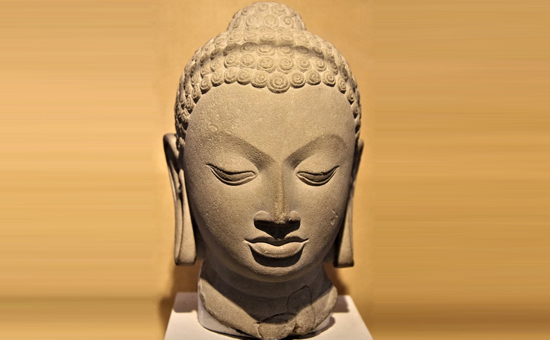 Buddha – Santatma lambakarnasca gauranga, one who is long-eared, and fair.
Buddha – Santatma lambakarnasca gauranga, one who is long-eared, and fair.
According
to TAG Rao, there are five kinds of earrings: patra-kundala, makara-kundala,
sankha-patra-kundala, ratna-kundala, and sarpa-kundala.
Patra-kundala refers
to cones made of coconut or palm leaves, or gold
leaves. Makara-kundala as the name suggests refers to the mythical
animal makara design of earrings made in wood, metal, or ivory.
Sankha-patra-kundala are earrings made of pieces of
conch-shells, Ratna-kundala are jewel encrusted earrings,
and Sarpa-kundalas were earrings designed in the shape of a cobra and made
of metals, ivory, or wood.
Sarpa-kundalas
are seen on Shiva, and also sometimes on Ganesha. Uma and other devis are often
seen wearing sankhapatra-kundalas,
while makara-kundala, and ratna -kundala can be seen on the
ears of any divinities, both male and female.
 Makarakundala (Image from TAG Rao, Elements of Hindu iconography).
Makarakundala (Image from TAG Rao, Elements of Hindu iconography).
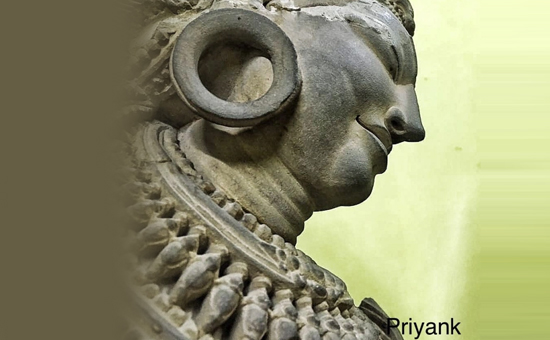 Large hoop earrings on a salbhanjika.
Large hoop earrings on a salbhanjika.
Interestingly
the nose ornament termed as vesara
(not a Sanskrit word) is not found in any of the ancient or early medieval
images. It is seen much later in the late medieval images, especially in murtis
of Radha and the gopinis, and this particular ornament is more likely a foreign
import that came in with the invaders.
Necklace
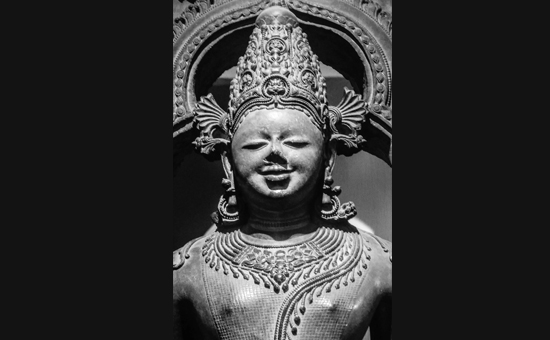 Surya wearing his magnificent hara/necklace, Konark, 13th c. CE
Surya wearing his magnificent hara/necklace, Konark, 13th c. CE
Various
kinds of necklaces form to be an essential part of in the bedecking of the
Indian deities, and some of the more popular necklaces are graiveyaka, hara, niska, etc.
The
earliest type of neck ornament is seen adorning the proto Shiva-Pashupati seal
from Harappa, where concentric rows of neck chains or torques adorn the deity’s
neck. In Rigveda (hymn 33) Rudra is described as adorned with a
beautiful niska, which denotes a
neck ornament, and E. Thomas and D. R. Bhandarkar had suggested in their papers
that it denotes a necklace made of niska coins, where sometimes it meant gold
coins, and in others simply coins.
Hara
also means a necklace or a torque, and there are various types of this ornament
seen on the different deities in ancient and medieval murtis. Surya is
especially known to be depicted with a pralambahari or
a long torque /necklace (Varahamihira); while Shiva is described in
various iconographic texts as being loaded with haras (harabhararpito Harah). Graiveyaka is another type of necklace
which is broad, and is seen on the necks and chests of Yaksas and other deities
of central India.
In
many instances these necklaces have jewel pendants, such as, Vishnu is shown
with the jewel kaustubha mani. The
long garland like necklace hanging from Vishnu’s neck and falling below his
knees, is known as vanamala or vaijayanti, and is five- formed, or made
up of five different types of jewels, such as pearls, rubies, nila, emeralds,
and diamonds.
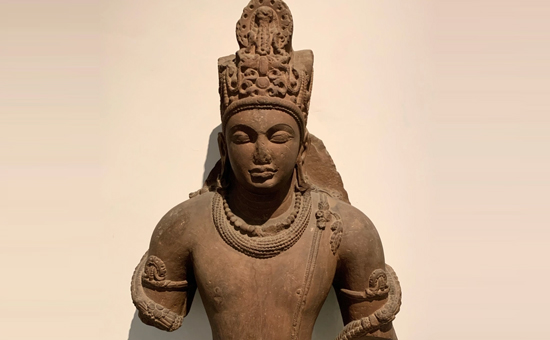 Vishnu wearing ornaments.
Vishnu wearing ornaments.
Caption
- Vishnu wearing various ornaments and upavita. The vanamala or vaijayanti is
partly broken here.
The
yagnapavita, in medieval era, is also
often depicted as a jewelled one accompanying the cotton one, worn in the upaviti fashion where it encircles the
torso from top of left shoulder and below the right arm. Sometimes the skin of
an antelope (krsnara) is seen
covering a part of the torso and hanging from the shoulder of deities like
Narayana and Nara.
Ornaments on the torso, waist, and ankles
A
popular ornament of the torso known as the channavira, is a form of flat chains over each shoulder in a cross
fashion, where the flat disc lies at the junction of the two chains on the
chest. It is particularly a favourite ornament seen on deities in south India. A
similar form of ornament is also seen in some figures at the Taxila museum, the
Besnagar Yakshini, and on the figure
of a Kulakoka devta in a Bharhut
pillar.
Two
other ornaments seen commonly on the torso of deities are known as udarabandha and kucchabandha. Both are flat bands, where
the latter is used for tying the breasts and holding them in position, and the
former for holding a protruding belly (seen in many Yaksa figures and other
minor deities).
Kucchabandha is seen only in
some female deities, especially when a male god (Vishnu or Subramaniam) is
shown with two consorts, and generally the devi on his right hand side is seen
wearing the kucchabandha.
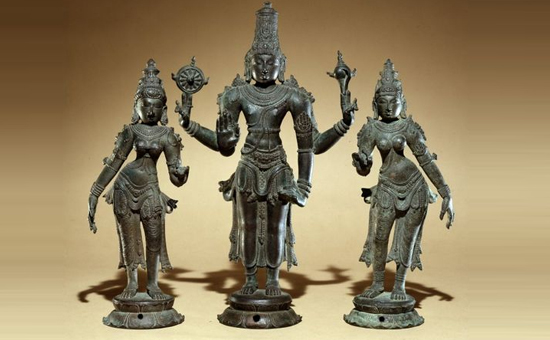 Devi on right of Vishnu is Sri Devi.
Devi on right of Vishnu is Sri Devi.
Caption
- Devi on right of Vishnu is Sri Devi and she is wearing a kucchabandha (breast
band). On his left is Bhu devi and she is without a breast band. Chola bronze,
British museum.
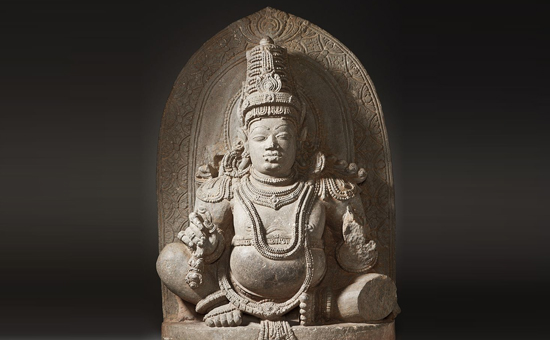 India, Karnataka, Varuna wearing udarabandha, 1050, at LACMA.
India, Karnataka, Varuna wearing udarabandha, 1050, at LACMA.
Waist
ornaments are of several types and seen on many deities.
The
various jewelled waistbands are known as mekhala (girdle), katibandha,
kancidama (a girdle with small
bells held together by chains). The Surya images are shown with the avyanga (waist
girdle), which has been likely derived from the Avestan sacred woollen thread
girdle worn by Zoroastrians. Ankles are also
shown with ornaments in many figures, wherein anklets in rows are
seen in female figures; and manjira,
an elliptical ornament, is often depicted on both male and female figures.
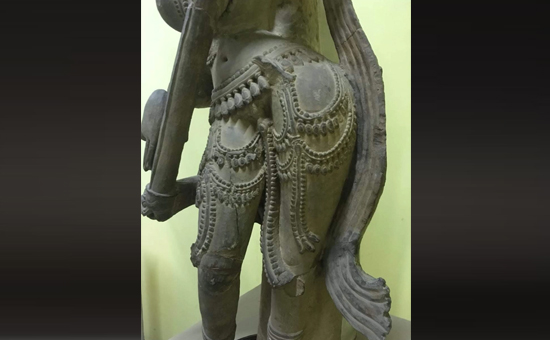 Waist ornaments.
Waist ornaments.
 Surya in his elaborate avyanga (waist girdle), Odisha.
Surya in his elaborate avyanga (waist girdle), Odisha.
Arm ornaments
Earliest
depictions of arm ornaments are seen in the Harappan seal showing the
Shiva-Pashupati from Mohenjo daro. Later the Maurya, Sunga and other dynasty
era images carry on with the trend and depict various types of arm ornaments on
the deities, the names of which are kankana,
valaya, keyura, angada, etc.
Kankana and valaya are worn on the lower arms at the wrist, while the keyura
and angada are worn on the upper arms just above the biceps.
Shiva
is seen wearing a bracelet at his wrist that is known as bhujanga-valaya, which is shaped like a
snake, and is designed as such that at the junction of the tail and the body of
the snake the hood rises. Sometimes armlets had little plaques fitted on them,
as for example, a Bodhisattava in the Mathura museum wears an armlet with a
plaque that shows a human figure riding a bird (peacock or garuda).
Palms
and fingers are also often shown with ornaments comprising of small round discs
held at the centre of the palm with chains crossing at the back, and fingers
are adorned with rings. In West Bengal this ornament is known as Ratanchura and is still popular
during marriages.
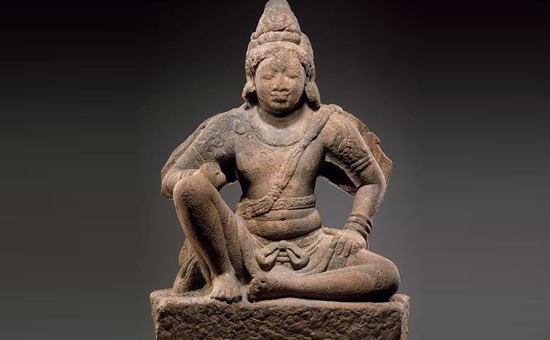 Garuda wearing armlets, bracelets, udarabandha, earrings, necklace, and upvita.
Garuda wearing armlets, bracelets, udarabandha, earrings, necklace, and upvita.
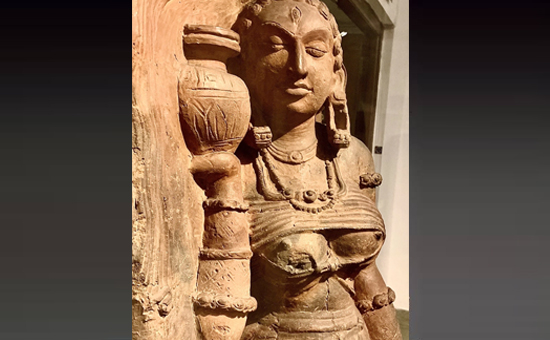 Devi Yamuna wearing thick bracelets, armlet, necklaces, and long hanging earrings.
Devi Yamuna wearing thick bracelets, armlet, necklaces, and long hanging earrings.
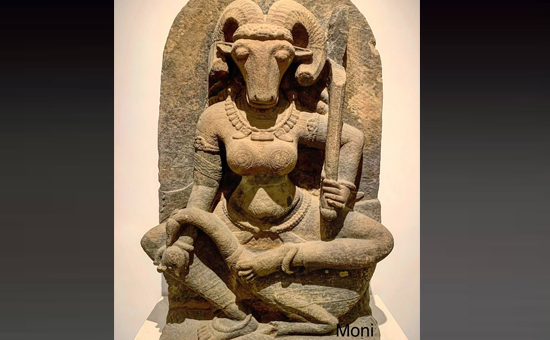 Yogini Vrishnana in her various ornaments.
Yogini Vrishnana in her various ornaments.
Our
deities and our temple art are a documentation of our ancestors and depict
their socio-religious customs, lifestyles, and the general way of living. Thus,
the jewellery that we see on our deities are what the people of those times
wore and what were in fashion; and some of these ornaments and designs,
starting from the Harappan times, still continue, showing the continuity within
our culture; perhaps the longest surviving religion and culture that is still
in practice, beginning from the prehistoric times until date.
References
TAG
Gopinath Rao, Elements of Hindu Iconography
To read all
articles by author
Author
studies life sciences, geography, art and international relationships. She
loves exploring and documenting Indic Heritage. Being a student of history she
likes to study the iconography behind various temple sculptures. She is a
well-known columnist - history and travel writer. Or read here
Article
was first published on author’s blog and here
Article and pictures are courtesy and copyright author.